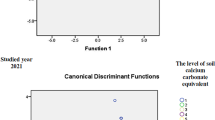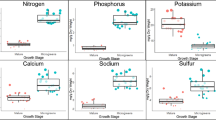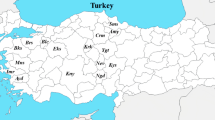Abstract.
Physico-chemical and nutritional composition from four different nopalitos (young cladodes from cacti): Blanco sin Espinas, Blanco con Espinas, Verde Valtierrilla (cultivated materials) and a wild material from the central region of México were studied at different sizes of harvesting. The first three are commercial crops. None of the tested materials exhibited superior characteristics in all of the evaluated parameters in relation to each one of them. In various cases properties of the wild crop were comparable, if not superior, to commercial ones. Some important changes were observed in total soluble solids, water content, texture, acidity and pH as affected by size of cladode and specific crop. Most cladode samples appear to be a good source of β-carotene and lutein. The presence of these compounds is important for human nutraceutical purposes.


Similar content being viewed by others
References
FAO (2001) Cactus as Forage (Opuntia spp.) Food and Agriculture Organization of the United Nations. pp 1–5.
Pimienta-Barrios E (1994) Prickly pear (Opuntia spp.): A valuable fruit crop for the semiarid lands of México. J Arid Environ 28: 1–11.
Muñoz-Chávez M, Chavez A, Valles V, Roldán JA (1995) The nopal: a plant of manifold qualities. Plant Foods Hum Nutr 77: 109–134.
Felker P, Singh G, Pareek OP (1997) Opportunities for the development of cactus (Opuntia spp.) in arid and semiarid regions. Ann Arid Zones 36: 267–278.
García-Saucedo P, Valdez-Morales M, Valverde-González ME, Cruz-Hernández A, Paredes-López O (2005) Plant regeneration of three Opuntia genotypes used as human food. Plant Cell Tiss Org Cult 80: 215–219.
Cantwell M (1991) Quality and postharvest physiology of “nopalitos’’ and “tunas.’’ In: Proceedings of the Second Annual Texas Prickly Pear Conference. Texas Prickly Pear Council, McAllen, Texas. pp 60–64.
Mizrahi Y, Nerd A, Nobel PS (1997) Cacti as crops. Hort Rev 18: 291–319.
Ruíz D, Egea J, Tomas-Barberan FA, Gil MI (2005) Carotenoids from new apricot (Prunus armeniaca L.) varieties and their relationship with flesh and skin color. J Agric Food Chem 53: 6368–6374.
Bliss FA (1999) Nutritional improvement of horticultural crops through plant breeding. Hort Sci 34: 1163–1167.
Sáenz C, Estevez AM, Sepúlveda E, Mécklenburg E (1998) Cactus pear fruit: A new source for a natural sweetner. Plant Foods Hum Nutr 52: 141–149.
Cárdenas-Medellín ML, Serna-Saldívar SO, Velazco de la Garza J (1998) Effect of raw and cooked nopal (Opuntia ficus indica) ingestion on growth and profile of total cholesterol, lipoproteins, and blood glucose in rats. Arch Latinoam Nutr 48: 316–323.
Bwititi PT, Machakaire T, Nhachi B, Musabayane CT (2001) Effects of Opuntia megacantha leaves extract on renal electrolyte and fluid handling in streptozotocin (STZ)-diabetic rats. Ren Fail 23: 316–323.
Sáenz C (2000) Processing technologies: An alternative for cactus pear (Opuntia spp.) fruits and cladodes. J Arid Environ 46: 209–225.
AOAC (1999) Association of Official Analytical Chemists Official Methods of Analysis. Chap 45, pp 4–5.
Delgado-Vargas F, Paredes-López O (1996) Correlation of HPLC and AOAC methods to assess the all-trans-lutein content in marigold flowers. J Sci Food Agric 72: 283–290.
Del-Villar Martínez AA, García-Saucedo PA, Cárabez-Trejo A, Cruz-Hernández A, Paredes-López O (2005) Carotenogenic gene expression and ultrastructural changes during development in marigold. J Plant Physiol 162: 1046–1056.
Rodríguez-Félix A, Cantwell M (1988) Developmental changes in composition and quality of prickly pear cactus cladodes (nopalitos). Plant Foods Hum Nutr 38: 83–93.
Villarreal F, Rojas-Mendoza P, Arellano V, Moreno J (1963) Estudio químico sobre seis especies de nopales (Opuntia spp). Ciencia Aplicada 22: 59–65.
Kader AA (1992) Postharvest Technology of Horticultural Crops. University of California special publication 3311, Oakland, CA.
Bravo-Hollis H, Sánchez-Mejorado H (1978) Las Cactáceas de México. Vol. 1, 2nd edition. UNAM, México.
Gallardo Y, Zambrano ML, Hernández AD (1997) Determinación de las propiedades fisicoquímicas del nopal verdura. Memorias del VII Congreso Nacional y V Congreso Internacional sobre Conocimiento y Aprovechamiento del Nopal. Monterrey, Nuevo León, México.
Seymour GB, Gross KC (1996) Cell wall disassembly and fruit softening. Postharv News Inform 7: 45N–52N.
Jaramillo-Flores M, González-Cruz M, Cornejo-Mazón L, Dorantes-Álvarez L, Hernández-Sánchez H (2003) Effect of thermal treatment on the antioxidant activity and content of carotenoids and phenolic compounds of cactus pear cladodes (Opuntia ficus-indica). Food Sci Tech Int 9: 271–278.
Palace VP, Khaper N, Qin Q, Singal P (1999) Antioxidant potentials of vitamin A and carotenoids and their relevance. Free Radical Biol Med 26: 726–761.
Acknowledgements
We acknowledge Sociedad Cooperativa “Productores Nopaleros de Valtierrilla, S.C.” for providing the biological material, and Dr. Rita Miranda (Instituto Tecnológico de Celaya) for helpful collaboration on physico-chemical determinations. Technical assistance by Dr. M. E. Valverde-González (CINVESTAV) is also acknowledged.
Author information
Authors and Affiliations
Corresponding author
Rights and permissions
About this article
Cite this article
BETANCOURT-DOMÍNGUEZ, M.A., HERNÁNDEZ-PÉREZ, T., GARCÍA-SAUCEDO, P. et al. Physico-Chemical Changes In Cladodes (Nopalitos) From Cultivated And Wild Cacti (Opuntia spp.). Plant Foods Hum Nutr 61, 115–119 (2006). https://doi.org/10.1007/s11130-006-0008-6
Received:
Accepted:
Published:
Issue Date:
DOI: https://doi.org/10.1007/s11130-006-0008-6




